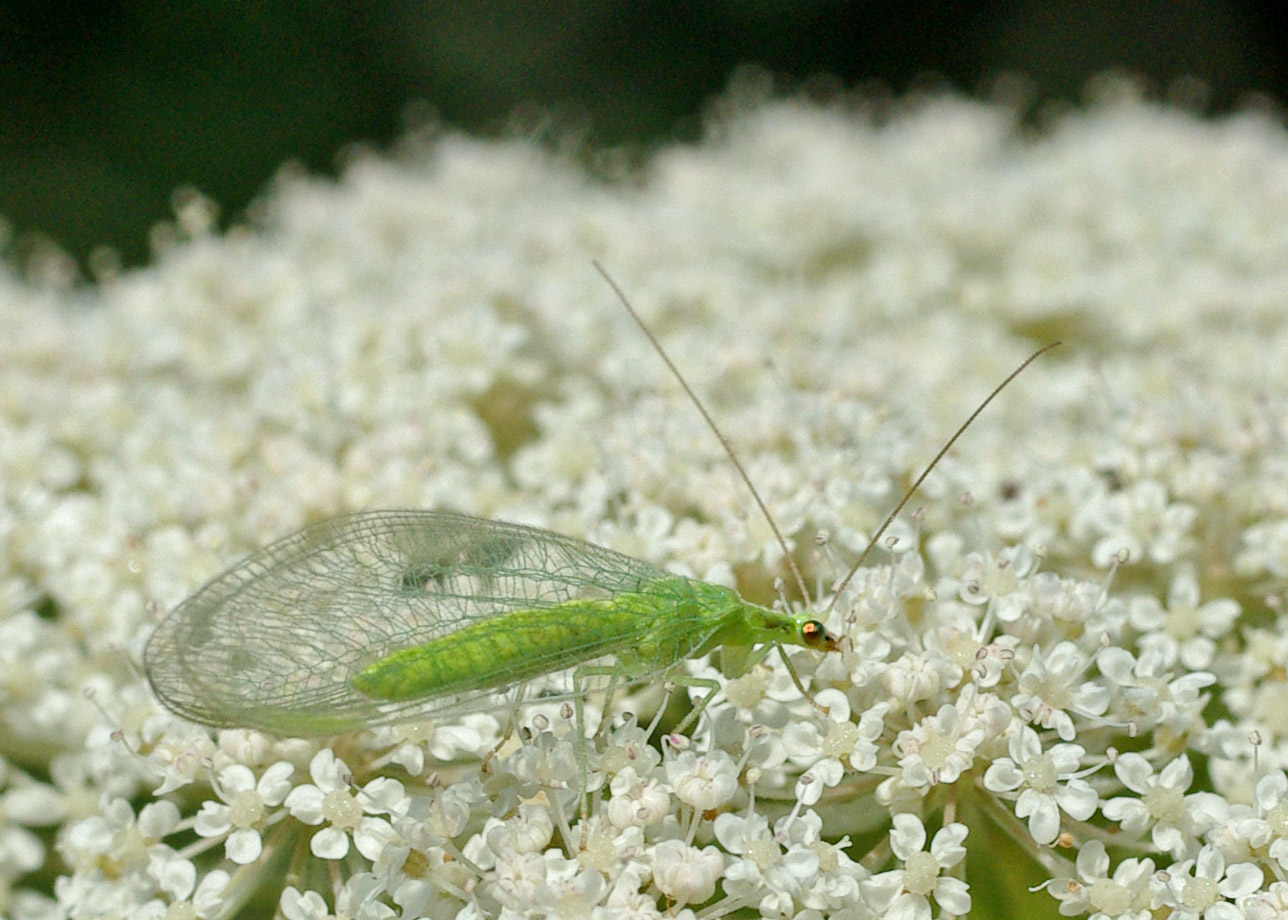
by Kate Redmond
Green Lacewings
Howdy, BugFans,
These lovely, fragile-looking insects have fluttered around the edges of several BOTWs over the past 17-plus years, and it’s time for them to have an episode of their own.
A bit about their pedigree: they are in the oddball order Neuroptera (“nerve-wing”), an order that’s undergone a fair amount of tinkering. Presently, it’s home to the doodlebugs/antlions, the owlflies, and a whole bunch of different varieties of lacewings; and it’s the former home of the snake, alder, fish, and Dobsonflies (hellgrammites). Neuropterans are soft-bodied insects with four, similarly-sized, conspicuously-veined wings, and chewing mouthparts, and they practice complete metamorphosis (going through egg, larva, pupa, and adult stages). Their larvae are predators.
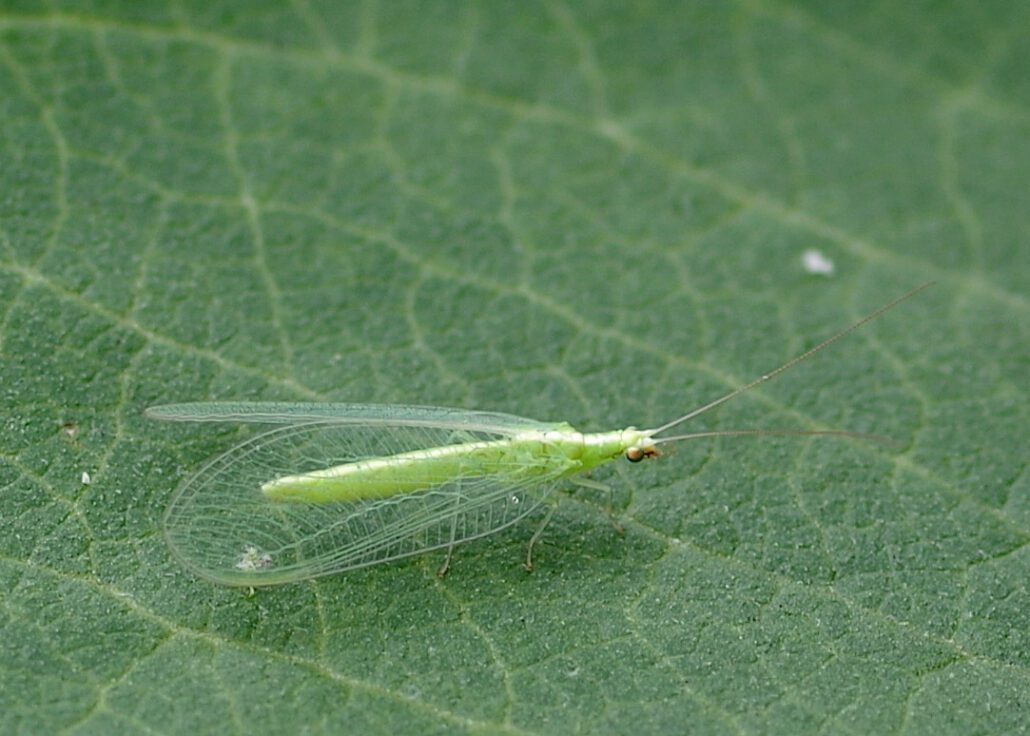
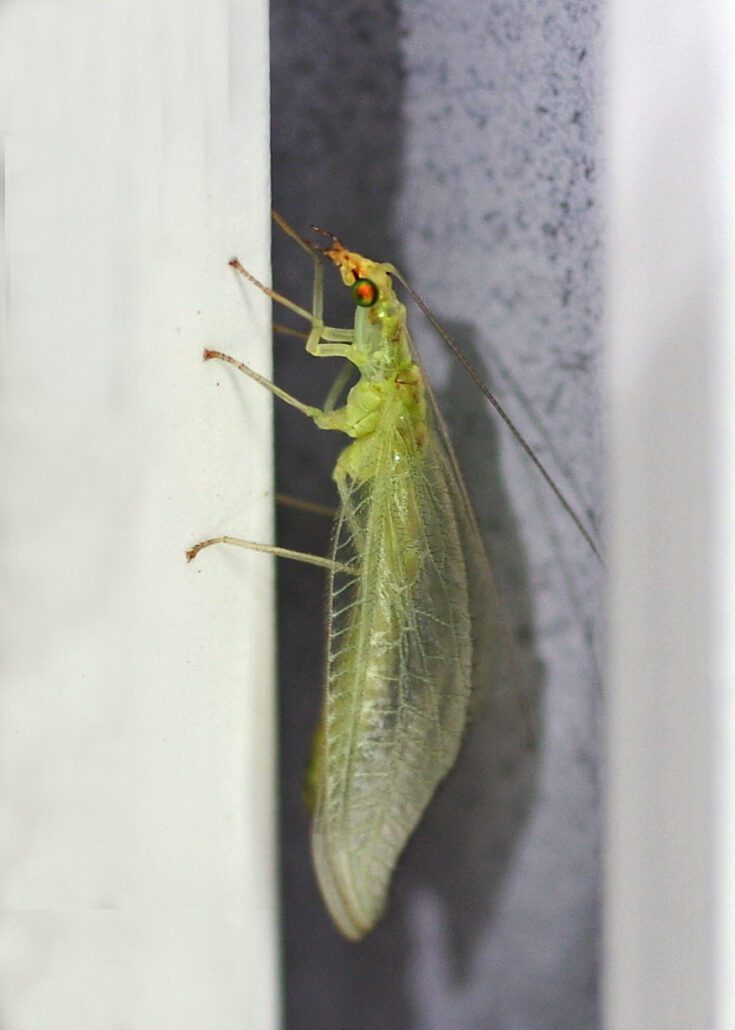
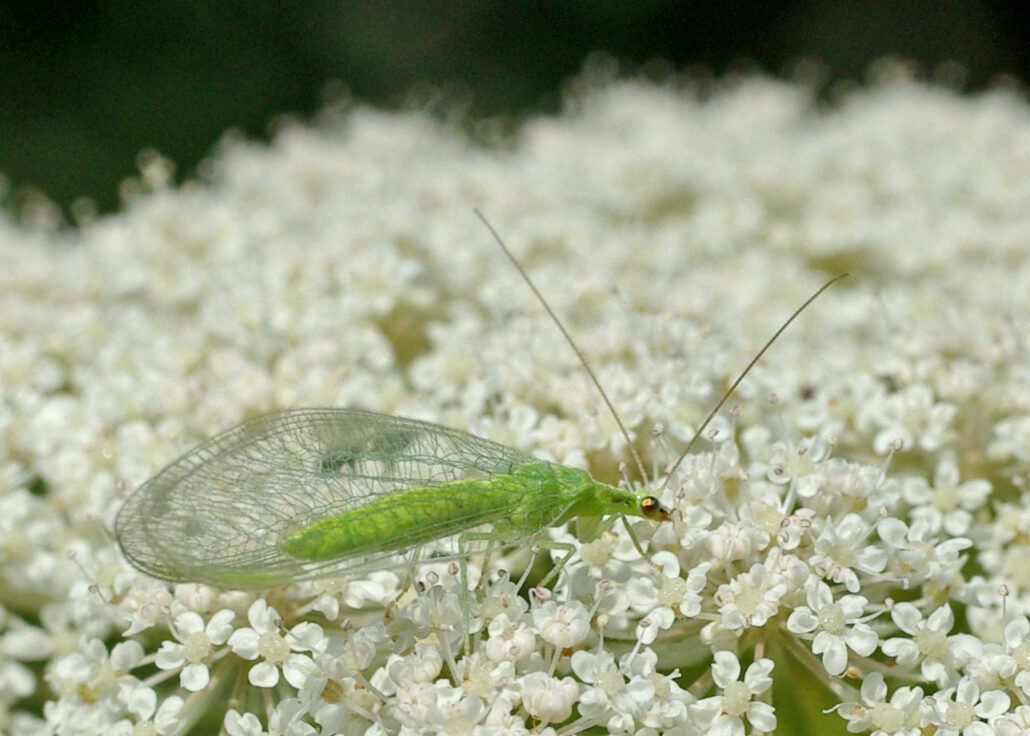
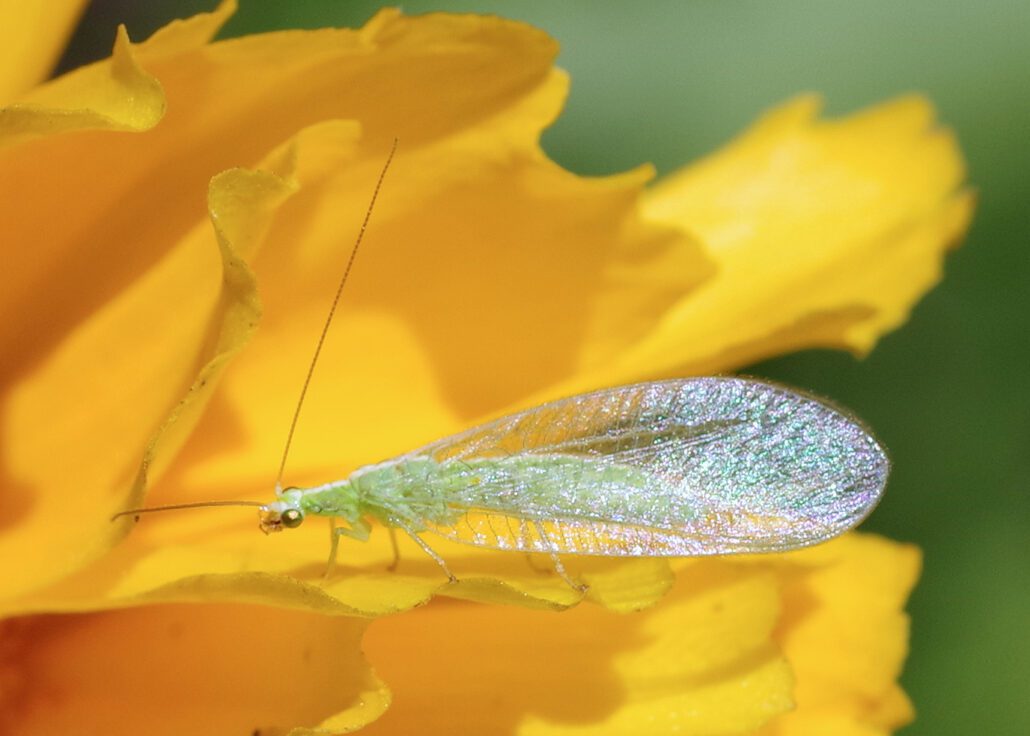
A note about Green lacewing taxonomy – members of the genus Chrysoperla are frequently encountered across North America, as are members of the genus Chrysopa. They look a lot alike, their photographs can be confusing, and various species have been swapped back and forth between the two genera for a long time (and at one point, many species were lumped as a single species). When the BugLady looks at the Green lacewing shots she’s taken over the years, a number of different species seem to be represented – pale dorsal stripes on some, small thoracic spots on others, no definitive markings at all on still others – so she will keep this general.
Green lacewings are in the suborder Hemerobiiformia, which includes the Dusty, Pleasing, Beaded, Brown, Giant and Moth, Mantid, Spoon-Winged, and Spongilla lacewing families as well as the Green lacewing family Chrysopidae (from the ancient Greek words for “gold” and “face”). They are also called Golden-eyed lacewings and “stinkflies” (because members of several genera release bad-smells when handled), and their larvae are known as aphid lions or aphid wolves.
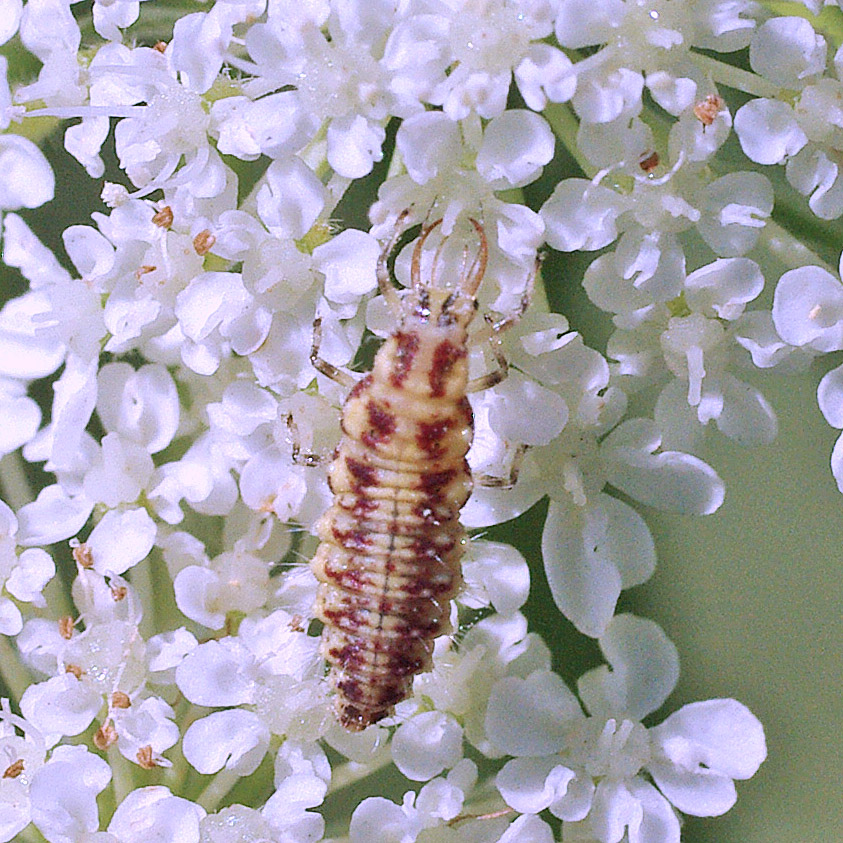
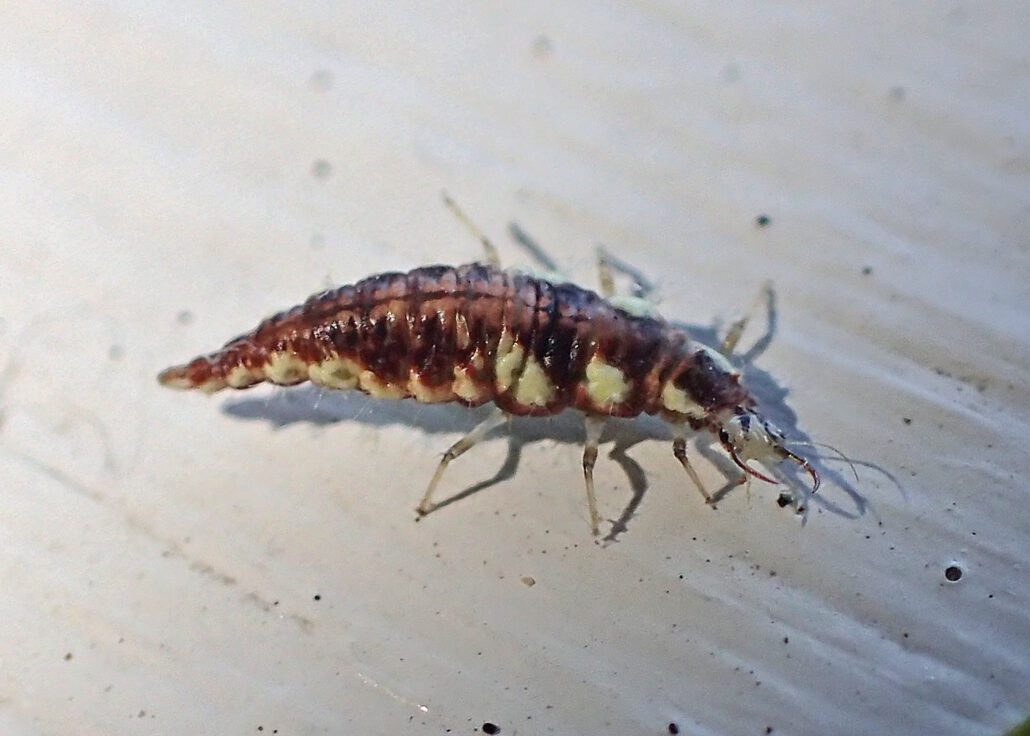
The “alligator-like” larvae live up to their nicknames, grabbing insects – including eggs, pupae, and caterpillars https://bugguide.net/ but especially aphids – with their sickle-shaped jaws, injecting them with a paralyzing venom, and sucking out the softened innards (https://bugguide.net/node/view/1182183/bgimage (which, in the case of an aphid, takes about 90 seconds). They often hold their prey aloft as they’re draining it. Some sources report that the larvae wave their abdomens back and forth as they roam the leaf tops, and others say that they swing their heads back and forth, seizing prey when they bump into it (their sense of touch is well-developed).
It’s also said that some species can account for 100 to 200 aphids a week, and if they can’t find their normal quota of prey, they have no qualms about eating other lacewing larvae. Depending on the species, adults may be predators, or they may be vegetarians that feed on nectar, pollen, and honeydew (the sugar water exuded by some bugs).
Lots of insects and spiders eat lacewings. Adults are nocturnal and are poor flyers, but they can hear the echolocation calls of bats and avoid them by folding their wings (presenting a smaller target) and dropping to the ground. Some parasitic wasps search out lacewing cocoons and lay their eggs on them, and their larvae eat the cocoon’s contents.
Green lacewings court by “singing.” Males vibrate their abdomen and send a signal out through the substrate, and females hear/feel his song through their legs and respond with their own, identical song, the pair singing part duet/part call-and-response. Even though we may not be able to tell species apart visually, their songs differentiate them.
Females make stalks by touching the underside of a leaf or twig with their abdomen and then pulling back, extracting a thread (manufactured in her reproductive system) that hardens immediately, and they place an egg on top of each stalk https://bugguide.net/node/view/2270799/bgimage (and some create a cool, spiral pattern https://bugguide.net/node/view/313076/bgimage). Eggs are laid where there are aphids nearby. It’s theorized that suspending the eggs protects them from predators, including their newly-hatched, immediately-hungry siblings. About three weeks after hatching, mature larvae spin cocoons in the vegetation https://bugguide.net/node/view/765647/bgimage, and adults emerge about five days later. There are several broods per year, and they overwinter as adults or as pupae.
Some species of Green lacewings have hairy/spiny, “trash-carrying” larvae – larvae that stick debris – and sometimes bits of dead prey – to their backs, creating a shield that they present to aggressors. Does the disguise help them avoid aphid-farming ants? Hide them from predators? Watch this very cool video: https://www.youtube.com/watch?v=fbRK6E5crbg.
Because of their dining habits, lacewing larvae are sold as a biological control of aphids, the Catch 22 being that when they’ve finished eating the aphids or mature as adults, they may move on.
A Note from the Pulpit: Because of their nocturnal habits, adult lacewings are often attracted to and killed by bug zappers. The vast (vast) majority of insects killed by bug zappers (about 95% in one study and more than 99% in another) are NOT target species like mosquitoes and other biting flies (which are not attracted to the zapper’s UV light). The vast (vast) majority are pollinators like moths, or predators like lacewings, or just innocent passers-by. At a time when insect numbers are going down globally, and we recognize all the “ecosystem services” they provide (including feeding the birds), the idea of this degree of collateral damage is repugnant.
Fun Lacewing Facts (from the North Carolina State College of Agriculture and Life Sciences).
- For many years, biologists thought their eggs were the fruiting bodies of a fungus they called Ascophora ovalis. The true nature of these eggs was first discovered in 1737 by Rene Reaumur, a French physicist, biologist and inventor.
- As larvae, lacewings and antlions do not have a complete digestive system: the midgut ends in a dead end. Waste materials accumulate in the midgut throughout larval development and are finally expelled only after a connection is made with the anus near the end of the pupal stage. The accumulated fecal material is called a meconium.
CICADA ADDENDA
Last week’s cicada story is the gift that keeps on giving.
ERRATUM: – the quote about cicadas mistaking people for trees, mistakenly attributed to the EPA, was actually from Cicada Mania. The BugLady thought it sounded a bit un-EPA-ish, but she had just been on their site, and her brain hiccoughed.
AND ELABORATION – https://www.scientificamerican.com/article/long-overlooked-benjamin-banneker-is-recognized-for-work-on-cicadas-and-against-slavery/. Thanks, BugFan Bob.
AND SUPER POWERS (Oh My!) – the wings of cicadas and a number of other groups like honey bees, butterflies, dragonflies and damselflies have what one scientists calls “anti-biofouling and antimicrobial” properties! Not chemically antimicrobial but structurally antimicrobial. How does that work? The surface of the wings is covered with “nanopillars” – columnar structures with a diameter of about 100 nanometers (one-one thousandth the diameter of a human hair), with “spikey” tips. Bacteria that land on them literally get impaled, tearing their cell walls, which kills them. The nanopillars are (somehow) self-cleaning, getting rid of the debris that might serve as a medium for more bacteria to grow. Scientists are hoping to copy the system https://www.sciencealert.com/cicada-wings-kill-superbugs-on-contact-and-we-may-finally-know-how. Stay tuned.
Kate Redmond, The BugLady
Bug of the Week archives:
http://uwm.edu/field-station/category/bug-of-the-week/
